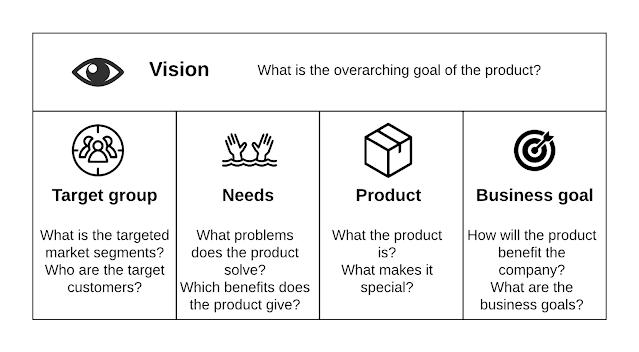Outlining the product with the Product Vision Board
Generally, the product vision is a short statement that encapsulates what a product is trying to achieve. The Product Vision Board (PVB) is a powerful tool that helps to communicate the project vision effectively [1]. It consists of the five sections shown in Figure 1.
 |
| Product Vision Board. (Based on [1].) |
The top section captures the product vision statement, the bottom sections contains four compartments that detail the product strategy:
- Vision: captures the overarching goal of the product. This statement guides every decisions concerning the product. It is usually expressed as a slogan or value statement
- Target group: describes the market or market segment, that are the potential users and customers
- Needs: states the main problems that the intended product want to solve, summarizes the value / benefit of the product for the target group
- Product: captures the main idea of the product (3-5 features) that are crucial for its success. It also give explanation on what the basic essence of the product and why it stands out
- Business goals: describe why to invest in the creation of the product and what are the business benefits for the company
Market Segmentation
- Mass market: serves a large group of customers without really differentiate their specific needs. The main goal is to provide solution to similar needs and problems. (e.g. Microsoft Word)
- Niche market: focuses on a very specific group of customers' needs (opposite from the mass market). (e.g. WinEdt)
- Segmented market: provides solutions to many different customer groups with different set of needs and problems. The provided solution is typically a slightly different version of the same product. (e.g. different Microsoft Office editions)
- Diversified market: comparing to the segmented market, it provides greatly different product versions e.g. different modules even different product names and value propositions to unrelated customer segments. (e.g. Amazon.com)
- Multi-sided market: serve interdependent customer segments that are linked but independent to each other. (e.g. eBay.com)
Specialties in the B2B Markets
- Complex decision making: Decision making is more complex the B2B markets as the purchase may involve many experts from various fields such as technical, purchasing experts or board members. Each of these participants having their own set of priorities.
- More rational behaviour: The B2B buyers are more rational customers as they tend to buy what they need - comparing with B2C buyers who generally buys what they want.
- More complex product: B2B products are usually more complex as they might have to be integrated into a larger system and using them requires qualified expert.
- Smaller audience: B2B target audiences are typically smaller than consumer counterparts. Even the largest B2B companies have 100 or fewer customers that really make a difference to sales.
- Personal relationship: Personal relationships are more important in B2B markets as in most B2B markets demand a level of personal service.
References
[1] Roman Pichler. Strategize: Product Strategy and Product Roadmap Practices for the Digital Age. Pichler Consulting, 2016. ISBN: 0993499201.
[2] Ash Maurya. Running Lean: Iterate from Plan A to a Plan That Works. O’Reilly Media, 2012. ISBN: 9781449305178.
[3] Alexander Osterwalder and Yves Pigneur. Business Model Generation: A Handbook for Visionaries, Game Changers, and Challengers. John Wiley and Sons, 2010. ISBN: 9780470876411.
[4] Heidi M. Neck, Christopher P. Neck, and Emma L. Murray. Entrepreneurship: The Practice and Mindset. SAGE Publications, Inc, 2016.






